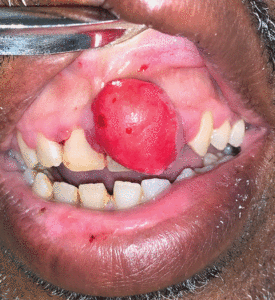Unveiling the Impact of Neglected Oral Hygiene: A Case of Benign Gingival Fibroma

In a compelling case report, a 60-year-old patient’s experience highlights the critical importance of oral hygiene in preventing benign oral masses. The patient, recovering from a stroke, developed a fibroma under the upper lip due to poor dental care during hospitalization. This case not only underscores the need for diligent oral care in hospital settings but also provides valuable insights into the differential diagnosis and management of gingival masses.
Key Points:
- A 60-year-old male, post-stroke rehabilitation patient, presented with a slowly growing mass under the upper lip, notable for minor bleeding gums after brushing.
- Physical examination revealed a large, firm, non-tender, sessile gingival mass on the upper incisors, erythematous and smooth without ulceration.
- Histopathological analysis post-excisional biopsy under local anesthesia identified the mass as a benign fibroma, characterized by fibrous strand proliferation without dysplastic changes.
- Differential diagnosis for gingival masses includes peripheral ossifying fibroma, peripheral giant cell granuloma, and pyogenic granuloma; fibromas typically arise due to trauma like accidental cheek biting.
- The patient’s gingival fibroma was attributed to poor oral hygiene during hospitalization, leading to plaque and calculus deposits acting as irritants.
- Excisional biopsy serves as both a diagnostic and curative approach for gingival fibromas, with laser removal also documented in literature.
- Emphasis on good oral hygiene is crucial for preventing recurrence of such oral masses.
- The case exemplifies the often-overlooked importance of oral health in hospital and outpatient settings, particularly for patients with prolonged hospital stays.

According to the WHO, severe periodontal diseases are estimated to affect around 19% of the global adult population, representing more than 1 billion cases worldwide.
More on Oral Health
